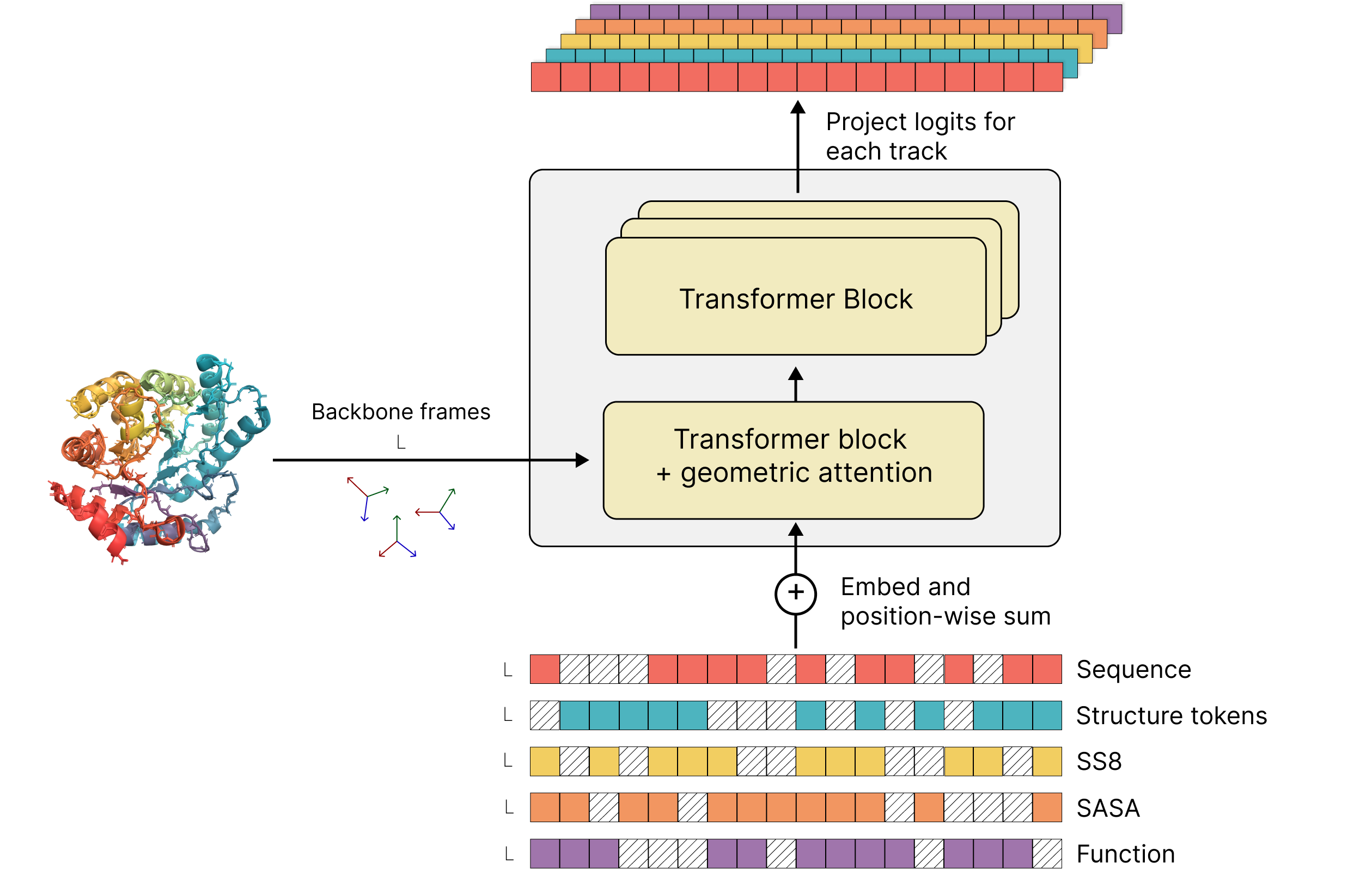ESM3 is a frontier generative model for biology, able to jointly reason across three fundamental biological properties of proteins: sequence, structure, and function. These three data modalities are represented as tracks of discrete tokens at the input and output of ESM3. You can present the model with a combination of partial inputs across the tracks, and ESM3 will provide output predictions for all the tracks.
ESM3 is a generative masked language model. You can prompt it with partial sequence, structure, and function keywords, and iteratively sample masked positions until all positions are unmasked. This iterative sampling is what the .generate() function does.
The ESM3 architecture is highly scalable due to its transformer backbone and all-to-all reasoning over discrete token sequences. At its largest scale, ESM3 was trained with 1.07e24 FLOPs on 2.78 billion proteins and 771 billion unique tokens, and has 98 billion parameters.
Here we present esm3-open-small. With 1.4B parameters it is the smallest and fastest model in the family.
ESM3-open is available under a non-commercial license.
Visit our Discussions page to get in touch, provide feedback, ask questions or share your experience with ESM3!
pip install esm
In order to download the weights, we require users to accept our non-commercial license. The weights are stored on HuggingFace Hub under HuggingFace/EvolutionaryScale/esm3. Please create an account and accept the license.
from huggingface_hub import login
from esm.models.esm3 import ESM3
from esm.sdk.api import ESM3InferenceClient, ESMProtein, GenerationConfig
# This will prompt you to get an API key from huggingface hub, make one with
# "Read" or "Write" permission and copy it back here.
login()
# This will download the model weights and instantiate the model on your machine.
model: ESM3InferenceClient = ESM3.from_pretrained("esm3_sm_open_v1").to("cuda") # or "cpu"
# Generate a completion for a partial Carbonic Anhydrase (2vvb)
prompt = "___________________________________________________DQATSLRILNNGHAFNVEFDDSQDKAVLKGGPLDGTYRLIQFHFHWGSLDGQGSEHTVDKKKYAAELHLVHWNTKYGDFGKAVQQPDGLAVLGIFLKVGSAKPGLQKVVDVLDSIKTKGKSADFTNFDPRGLLPESLDYWTYPGSLTTPP___________________________________________________________"
protein = ESMProtein(sequence=prompt)
# Generate the sequence, then the structure. This will iteratively unmask the sequence track.
protein = model.generate(protein, GenerationConfig(track="sequence", num_steps=8, temperature=0.7))
# We can show the predicted structure for the generated sequence.
protein = model.generate(protein, GenerationConfig(track="structure", num_steps=8))
protein.to_pdb("./generation.pdb")
# Then we can do a round trip design by inverse folding the sequence and recomputing the structure
protein.sequence = None
protein = model.generate(protein, GenerationConfig(track="sequence", num_steps=8))
protein.structure = None
protein = model.generate(protein, GenerationConfig(track="structure", num_steps=8))
protein.to_pdb("./round_tripped.pdb")Congratulations, you just ran a chain of thought with ESM3! Let's explore some more advanced prompting examples:
Open examples/generate.ipynb in Colab
You can apply for beta access to the full family of ESM3 models at EvolutionaryScale Forge.
We encourage users to interact with the Forge API through the python esm library instead of the command line.
The python interface enables you to interactively load proteins, build prompts, and inspect generated proteins.
Additionally, users can seamlessly swap between esm.models.esm3.ESM3 running locally, and
esm.sdk.forge.ESM3ForgeInferenceClient connecting to the Forge API.
Once the forge client is released, we'll be able to do something like:
model: ESM3InferenceClient = ESMForgeInferenceClient("esm3_sm_open_v1").to("cuda")
...and the exact same code will work. This will enable seamless access to our large 98B protein language models for protein design work.
EvolutionaryScale is a public benefit company. Our mission is to develop artificial intelligence to understand biology for the benefit of human health and society, through partnership with the scientific community, and open, safe, and responsible research. Inspired by the history of our field as well as new principles and recommendations, we have created a Responsible Development Framework to guide our work towards our mission with transparency and clarity.
The core tenants of our framework are
- We will communicate the benefits and risks of our research
- We will proactively and rigorously evaluate the risk of our models before public deployment
- We will adopt risk mitigation strategies and precautionary guardrails
- We will work with stakeholders in government, policy, and civil society to keep them informed
With this in mind, we have performed a variety of mitigations for esm3-sm-open-v1, detailed in our paper
The Big Picture:
-
The EvolutionaryScale AI Model is only available under this Community License Agreement for non-commercial use by individuals or non-commercial organizations (including universities, non-profit organizations and research institutes, educational and government bodies).
-
You may not use the EvolutionaryScale AI Model or any derivative works of the EvolutionaryScale AI Model or its outputs:
-
in connection with any commercial activities, for example, any activities by, on behalf of or for a commercial entity or to develop any product or service such as hosting the AI Model behind an API; or
-
without attribution to EvolutionaryScale and this Community License Agreement; or
-
to train any other large language model, any technology for protein representation learning or protein generation or any other AI-powered third party model similar to EvolutionaryScale’s AI Model, even for non-commercial usage.
-
You can publish, share and adapt the EvolutionaryScale AI Model and its outputs for non-commercial purposes in accordance with the Community License Agreement, including the requirement to restrict the usage of any reproductions and copies by, on behalf of or for a commercial entity or for any commercial purpose.
Please refer to our non-commercial license for details.
